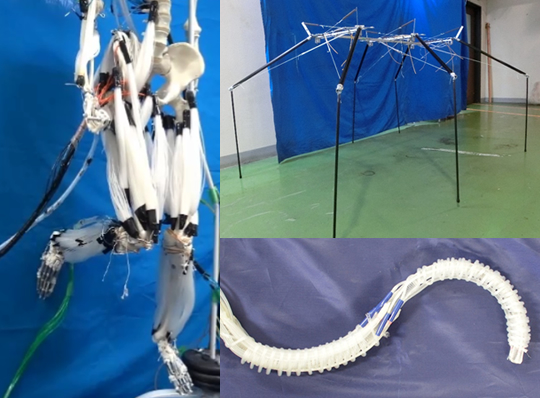University-Born Venture Established for Thin, Flexible Artificial Muscle
Developed and going on sale as a key device for nursing care power suits and humanoid robots
The company s-muscle was established on April 1 as a joint venture of Tokyo Tech and Okayama University, and will commence sales of thin artificial muscle powered pneumatically. Conventional artificial muscles available on the market had an outer diameter of 10 to 40 mm. This artificial muscle has a thin outer diameter of 2 to 5 mm, much thinner and more flexible. By weaving these in as muscle fibers, applications of light, soft, and comfortable support suits and corsets for nursing care can be anticipated.
This "artificial muscle" could also be the breakthrough needed for nursing care instruments and new robots, such as humanoid robots with movement as smooth as humans or ultra-lightweight robots.
The plan is to commence sample shipments in July to user manufacturers and research institutions using artificial muscles with the aim of developing uses and applications. General sales to small-lot users over the Internet are planned to start in the next fiscal year.
This artificial muscle has been the subject of research since 2011, led by those such as Professor Koichi Suzumori of the School of Engineering, Tokyo Tech and Associate Professor Shuichi Wakimoto of the Graduate School of Natural Science and Technology, Okayama University. During that course, many manufacturers and research institutions related to apparel, nursing care instruments, robots, and the like requested the use of this artificial muscle. As a result, the company was established by Professor Suzumori and Associate Professor Wakimoto, in cooperation with Ikeda Seichusho Co., Ltd. and Koganei Corporation.
Overview of thin artificial muscles
There are several methods in the research and development of artificial muscles. The method developed by s-muscle is one called McKibben artificial muscle[1]. This artificial muscle is thin, flexible, light, and strong, which is not seen in conventional models. By using these characteristics, various applications such as soft machines for contact with humans and new robot mechanisms can be anticipated.
Samples of thin artificial muscle to be sold
The outer diameter is 2 to 5 mm, with a contraction ratio[2]of 20 to 25% and a maximum contraction force[3]of approximately 30 kgf per 1 cm2. Multiple artificial muscle fibers can be bundled to construct various forms of muscle.

Application for support suits
By weaving it into fabric form, we aim for application into power suits and supporters which are soft, light, and comfortable.

The research on Powered Suits was partially supported by Cross-ministerial Strategic Innovation Promotion Program in FY 2014/2015.
Application for robots
It can be applied to new robots, such as ultra-lightweight or long-body robots, humanoid musculoskeletal robots, and soft robotics.

Future developments
In July of this year, we will commence sample shipments of artificial muscle for functionality testing to manufacturers and research facilities considering application of thin artificial muscle to support suits, nursing care equipment, and robotics. Three types will be made available—with outer diameters of 2 mm, 2.5 mm, and 4.8 mm— and will be sold in forms in response to requests, such as for artificial muscle only, assembled product, or driving units. At s-muscle, the customer, Tokyo Institute of Technology, and Okayama University will collaborate to advance the design, development, and application options of thin artificial muscle. Parts of operations such as sales and manufacturing will be entrusted to Ikeda Seichusho and Koganei.
Low-cost artificial muscle for popular use is scheduled to be made available by spring 2017. In cooperation with customer manufacturers and research institutions, we will endeavor to propagate support suits, nursing care equipment, robotics, and other applications of thin artificial muscle. We also plan to seek popularization of this artificial muscle by commencing small-lot sales to general users over the Internet.
Explanations of Technical Terms
1. McKibben artificial muscles : A structure of a rubber tube covered with knit mesh. Supplying air inside the tube causes it to contract along the length of the tube. The principle was developed in the U.S.A. around 1960 and several companies manufacture it today. Other types of artificial muscle have been developed, such as those using polymeric materials or electrostatic force. However, McKibben artificial muscle is the only type which has been able to attain the power and contraction force necessary for practical applications.
2. Contraction ratio : The value of the length the artificial muscle fiber contracted divided by the original length of the artificial muscle. For example, if an artificial muscle 100 mm in length contracts to 75 mm, the length contracted is 25 mm, making the contraction ratio 25%. Generally, the higher the contraction ratio, the better its performance.
3. Maximum contraction force : The contraction force of a McKibben artificial muscle depends on the length of expansion, with the maximum force at the maximum state of expansion. The contraction force at this point is called the maximum contraction force. The maximum contraction force depends on the cross-sectional area of an artificial muscle, with approximately 30 kgf of force per 1 cm2. For example, the cross-sectional area of an artificial muscle with an outer diameter of 2.5 mm is approximately 0.5 cm2, resulting in a maximum contraction force of approximately 15 kgf (kgf is the same as the unit called kg in daily life).
. Any information published on this site will be valid in relation to Science Tokyo.






